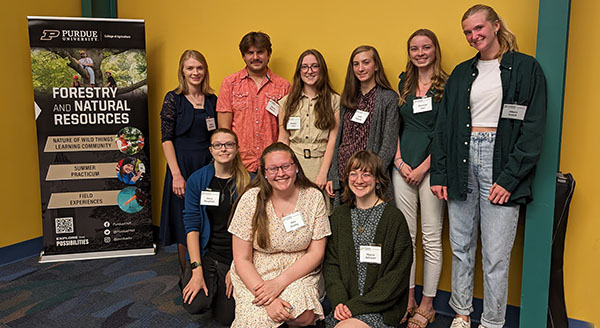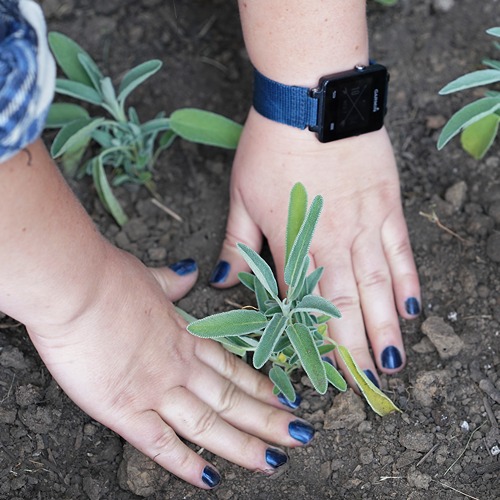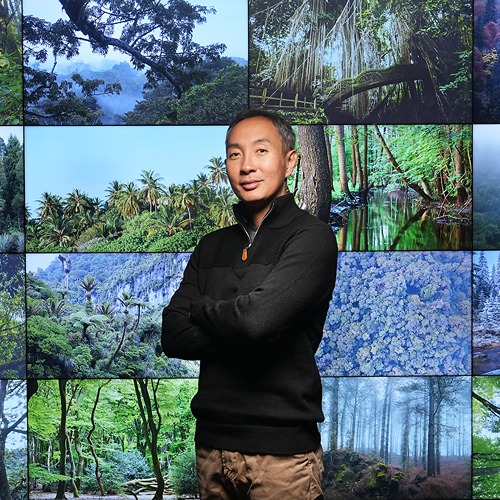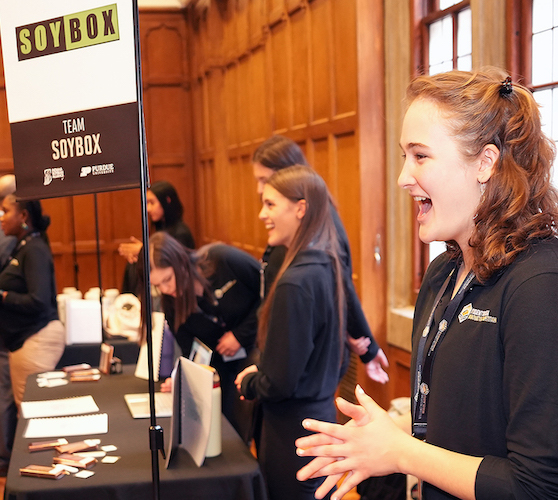Before Lauren Wetterau graduated with her degree in wildlife in December, she had one more adventure on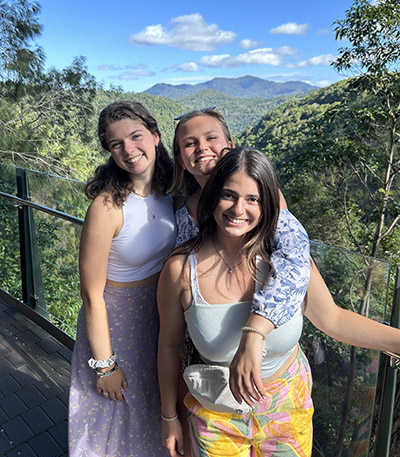 her Purdue checklist, a semester studying abroad in Australia.
her Purdue checklist, a semester studying abroad in Australia.
“I started talking to my advisor about it a couple years ago so that we could determine the best semester for me to go,” Wetterau explained. “We decided it was best for me to do my exchange experience for my final semester, which allowed me to get all the more specific courses out of the way first. A year before my exchange semester, I started meeting with a study abroad advisor who helped me get on the right track to finding a program that was right for me. Australia seemed like the best place to go because of its unique wildlife and proximity to the Great Barrier Reef! I compared all the program offerings in Australia and liked the class selection of the University of Queensland the best, so that’s how I ended up at UQ in Brisbane.”
Although she had completed many degree requirements on campus at Purdue, the Columbus, Ind., native still had four courses to take to finish up her wildlife studies: genetics, a botany elective and two wildlife electives. Lauren enrolled in Genetics, Plant Interactions, Marine Wildlife Conservation and Coral Reef Ecology at UQ, not knowing the challenges that awaited her.
“The classes I took during this study abroad experience challenged me more than I ever thought they would, and I am so grateful for that,” Wetterau recalled. “In Australia, most classes contained about three to five large assignments to determine a student’s grade. This contrasted with the class structure to which I have become accustomed, where students earn their grades through far more assignments and other forms of grading. Because most of my classes had so few grades, the assignments were each extremely important and complex in order to test students’ knowledge and extract what they learned. As a result, I worked harder than I have ever worked in my life because each assignment and exam was crucial to my passing the class. It felt like the entire semester was finals week! But, regardless of the huge amount of energy this required, I pushed through and succeeded. While I’ve been challenged in other classes and experiences before, I had never been forced to maintain such a level of focus and time management as this semester. It was draining, frustrating, and exhausting, but I did it. This taught me a lot about myself and my work ethic, and I am proud of what I accomplished.”
Despite the challenges of classwork, Lauren’s courses also afforded her the chance to attend class field trips to exotic locales. A weekend trip that included one day of whale population surveys and one day of dugong sampling was required for her Marine Wildlife Conservation course, while her Coral Reef Ecology class spent a week on Heron Island on the southern part of the Great Barrier Reef.
 One of the research boats for dugong sample surveys; Theodolite devices for measuring distances and angles to help with tracking the position and movements of whales; The whale behavior identification sheet that was used as a guide for labeling every behavior students observed
One of the research boats for dugong sample surveys; Theodolite devices for measuring distances and angles to help with tracking the position and movements of whales; The whale behavior identification sheet that was used as a guide for labeling every behavior students observed
The Heron Island trip included a research project that involved the spatial distribution analysis of corals on a reef flat. Her group surveyed three different areas on the reef flat during low tide to assess what coral genera were located there. At each site, they set up a 10 meter by 10- meter quadrat and used smaller 1x1 gridded squares within it to determine the dominant genera present in each square. They then mapped the data and converted it to an excel spreadsheet and then ran an analysis. The goal was to determine nearest neighbor information, to see what corals were typically found close to each other versus what corals were typically spaced farther apart from one another.
“We found that coral genera that were known to have dominant, quick growth characteristics were rarely, if ever, seen close to each other, which indicates competition between the genera and makes sense due to their similar use of resources,” Lauren explained. “It was really challenging work because I’d never even seen a coral in person before, let alone identified one by its genera, and here my entire project relied on my group identifying the corals. On top of that, I had never done this kind of analysis before. But it was such a great experience and I enjoyed being challenged in a new way.
“Data analysis has never been one of my strongest skills and I was very intimidated by the complexity of the analysis I had to do, but I overcame my uncertainties and did it! I was so proud of myself for my hard work and I know that moving forward into my master’s program research and future careers beyond that I will have the tools to figure out any problem that comes my way.”
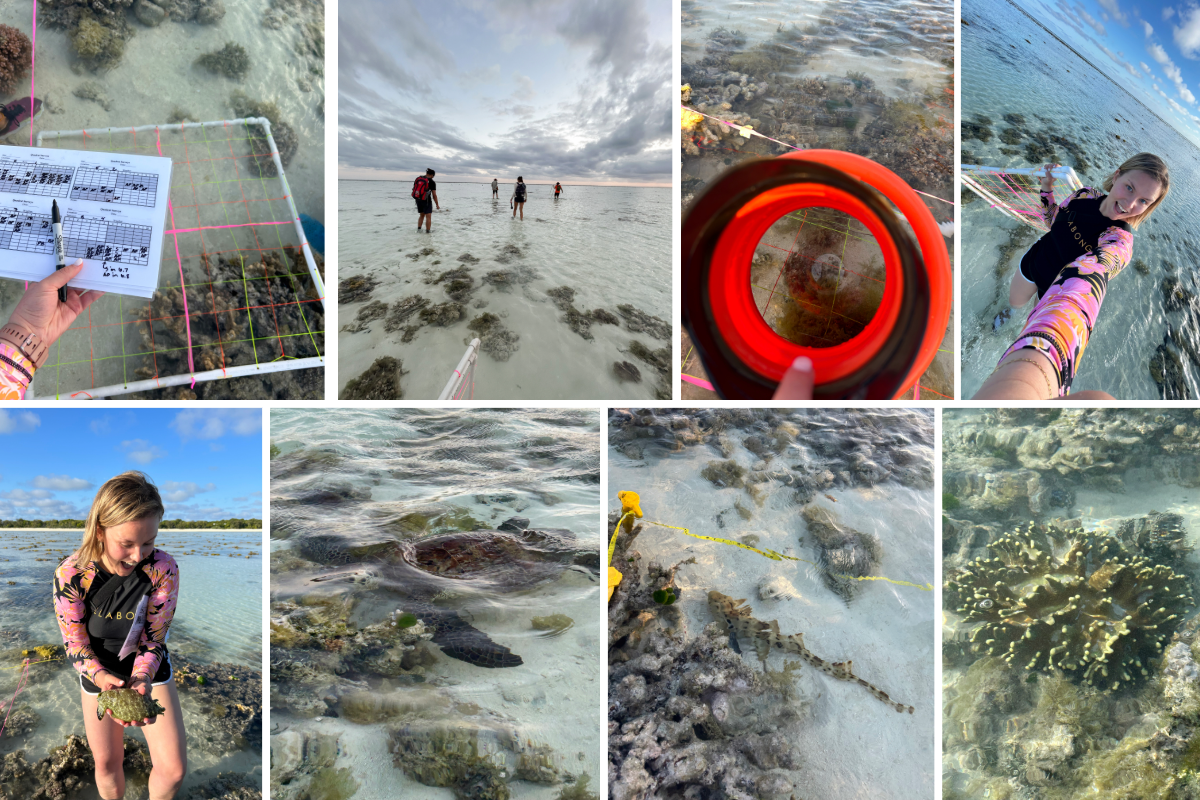 Top Row (Left to Right): Labeling coral genera presence grid by grid on a data sheet; Lauren's group walking out to their reef flat site; The group used a bathyscope to get a better view of the corals under the water. Lauren says identifying corals could be very tricky, especially if there was wind or heavy sunlight, so the bathyscope helped reduce those variables; Walking back to shore from our reef flat field site one morning.
Row 2: Lauren holding a see hare; Students passed by a green turtle on their way back to shore one morning; A curious epaulette shark came to investigate the quadrat surveys; A fire coral
Top Row (Left to Right): Labeling coral genera presence grid by grid on a data sheet; Lauren's group walking out to their reef flat site; The group used a bathyscope to get a better view of the corals under the water. Lauren says identifying corals could be very tricky, especially if there was wind or heavy sunlight, so the bathyscope helped reduce those variables; Walking back to shore from our reef flat field site one morning.
Row 2: Lauren holding a see hare; Students passed by a green turtle on their way back to shore one morning; A curious epaulette shark came to investigate the quadrat surveys; A fire coral
While learning new research techniques, Wetterau felt comfortable in her courses in Australia due to her past coursework in Purdue Forestry and Natural Resources.
“I was really happy to be able to apply so many skills from my FNR studies to the assignments and projects at UQ,” Wetterau said. “I used my scientific writing experience to write reports for three different classes. Having this experience with scientific writing gave me the confidence to face these report assignments in my UQ classes. I also relied on my FNR group project experiences to help me work as an effective and reliable teammate through all of the groupwork I helped with over the semester. Finally, I applied my field work experience to my field trips, especially when dealing with coral reef quadrat surveys.”
Beyond the classroom, studying abroad in Brisbane brought Lauren experiences of a lifetime.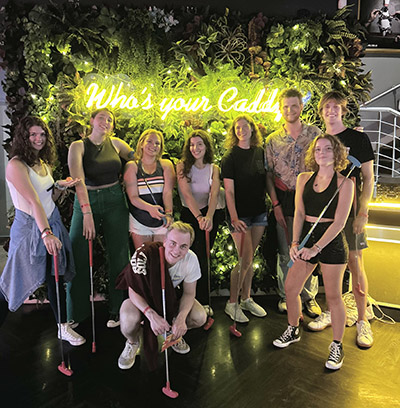
“Studying with students and faculty from all over the world was such a cool, unique opportunity for me to learn in a new way amongst peers that had far different educational backgrounds from my own,” she shared. “I will take all of my adventures and memories with me for the rest of my life. And most of these memories were made with people I didn’t know prior to arriving in Australia in July. Now I have friends all over the world. Before I left for Australia, I anticipated making a few friends, but I did not anticipate how great those friendships would become, nor did I anticipate those friendships to be the highlight of my whole study abroad experience. Sharing this unique, once-in-a-lifetime adventure with them was definitely my favorite part of my study abroad.”
Many of Wetterau’s new friends were made at the International House (IH), an on-campus student housing organization where the majority of its residents are international. About 25 other semester exchange students also lived at IH, and Lauren says she became extremely close with many of them, who came from other parts of the United States, as well as Germany, France, Switzerland, Belgium, Spain, the UK, Austria, and more.
 Lauren with friends from the International House; the International House building
Lauren with friends from the International House; the International House building While Lauren worked hard in her courses, she also found time to explore all that Australia had to offer. She went hiking in Tasmania, snorkeled with sea turtles and stingrays, collected data on corals in the Great Barrier Reef, attended a FIFA Women’s World Cup soccer game, and rode a train through and a sky gondola above the rainforest that inspired the scenery in the movie Avatar, just to name a few.
“I took classes at one of the best universities in the world for environmental science. I made lifelong friendships with other exchange students from all over the world. It’s almost unbelievable how incredible my time in Australia was. It was truly a once in a lifetime opportunity for which I will never stop being grateful,” Wetterau gushed upon her return to the United States.
Lauren’s specific travels included a trip to Noosa, a “cute little beach town” four hours north of Brisbane, where she stayed in a hostel with a bunch of friends, watched the sun rise over the ocean and went for a long hike along the coast.
Another excursion took Wetterau and a friend from the United States on a charter bus trip up the coast from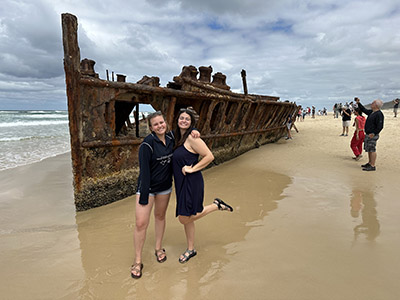 Brisbane to Cairns over mid-semester break. The duo toured K’gari Island, a sand dune island known for its shipwrecks and population of wild dingoes. They visited Whitsundays, a cluster of islands in the Great Barrier Reef. They took a train up into the mountain rainforest north of Cairns, explored a small town at the top and took a sky gondola back down the mountain. They took a ferry to Green Island in the Great Barrier Reef where they snorkeled and took a glass bottom boat ride to see a large outer reef. Lauren then met up with some friends and drove back to Brisbane through the Outback, which she says was “one of the coolest experiences of my entire time in Australia.” The two-day journey was full of wild kangaroos, wallabies and emus and even a huge herd of cows on the road they were driving down.
Brisbane to Cairns over mid-semester break. The duo toured K’gari Island, a sand dune island known for its shipwrecks and population of wild dingoes. They visited Whitsundays, a cluster of islands in the Great Barrier Reef. They took a train up into the mountain rainforest north of Cairns, explored a small town at the top and took a sky gondola back down the mountain. They took a ferry to Green Island in the Great Barrier Reef where they snorkeled and took a glass bottom boat ride to see a large outer reef. Lauren then met up with some friends and drove back to Brisbane through the Outback, which she says was “one of the coolest experiences of my entire time in Australia.” The two-day journey was full of wild kangaroos, wallabies and emus and even a huge herd of cows on the road they were driving down.
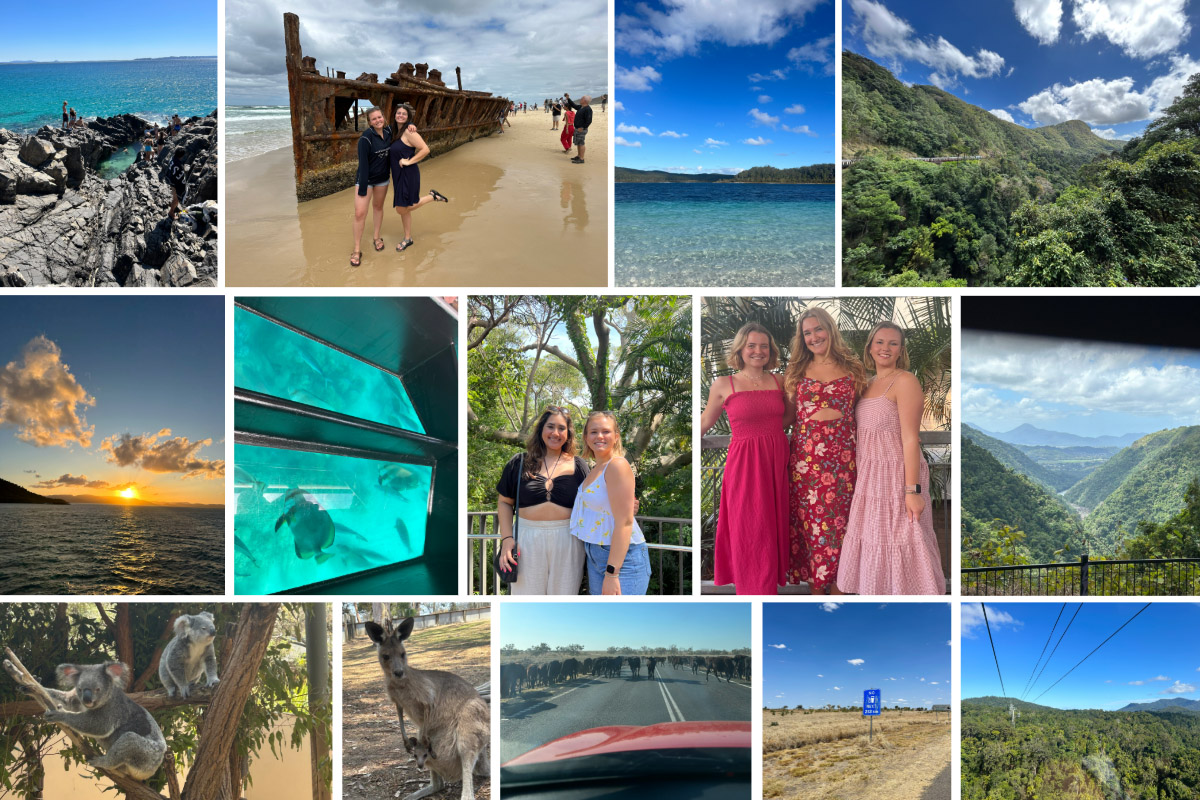 Photos from Lauren's trips to Noosa, K'gari Island, Green Island and through the Outback: Top row: A fairy pool in Noosa; Lauren with a U.S. friend at a shipwreck on K'gari Island; Lake Mckenzie on K'gari Island; the Kuranda Scenic Railway. Row 2: A sunset in Whitsundays; View through a glass bottom boat; Lauren and an American friend pose in front of trees; Lauren with friends from the UK and Germany; view from the KSR train. Row 3: koalas in a sanctuary; a kangaroo and joey; cows blocking the road in the Outback; a no-gas sign in the Outback; the Kuranda skyrail.
Photos from Lauren's trips to Noosa, K'gari Island, Green Island and through the Outback: Top row: A fairy pool in Noosa; Lauren with a U.S. friend at a shipwreck on K'gari Island; Lake Mckenzie on K'gari Island; the Kuranda Scenic Railway. Row 2: A sunset in Whitsundays; View through a glass bottom boat; Lauren and an American friend pose in front of trees; Lauren with friends from the UK and Germany; view from the KSR train. Row 3: koalas in a sanctuary; a kangaroo and joey; cows blocking the road in the Outback; a no-gas sign in the Outback; the Kuranda skyrail. A trip to the Sydney Opera House with another American friend provided another highlight.
“Seeing the Sydney Opera House in person was such a shock because it’s one of those things you see in pictures and movies your whole life, and then suddenly it’s there right in front of you,” she said.
A road trip to Tasmania after the semester ended saw Lauren and a friend from Germany take a challenging but memorable hike in the Cradle Mountains.
“We meant to take a walking path that went around the perimeter of a big lake, but we took a wrong turn halfway through and ended up on a long arduous hike,” Wetterau recalled. “We were a third of the way up a mountain when we realized our mistake! By that point, we agreed to keep going and see what we could do, and I’m really glad we did. The views were incredible!”
Lauren squeezed in one final sightseeing trip before returning home, visiting Melbourne and taking a tour of the scenic coastal views along the Great Ocean Road.
After all of her adventures in her studies, meeting new people and traveling, Lauren says the study abroad experience is one that everyone should take part in if they are able.
“To students considering studying abroad, I say just go for it,” Wetterau declared. “When else are you going to have an opportunity like this?! My time in Australia taught me so much about myself and connected me with lifelong friends from all over the world. It was a chance for me to step out of my comfort zone and try new things, which is so important. I also think it is important for students in the natural resources field to learn about wildlife and ecosystems in other parts of the world to better understand our planet!”
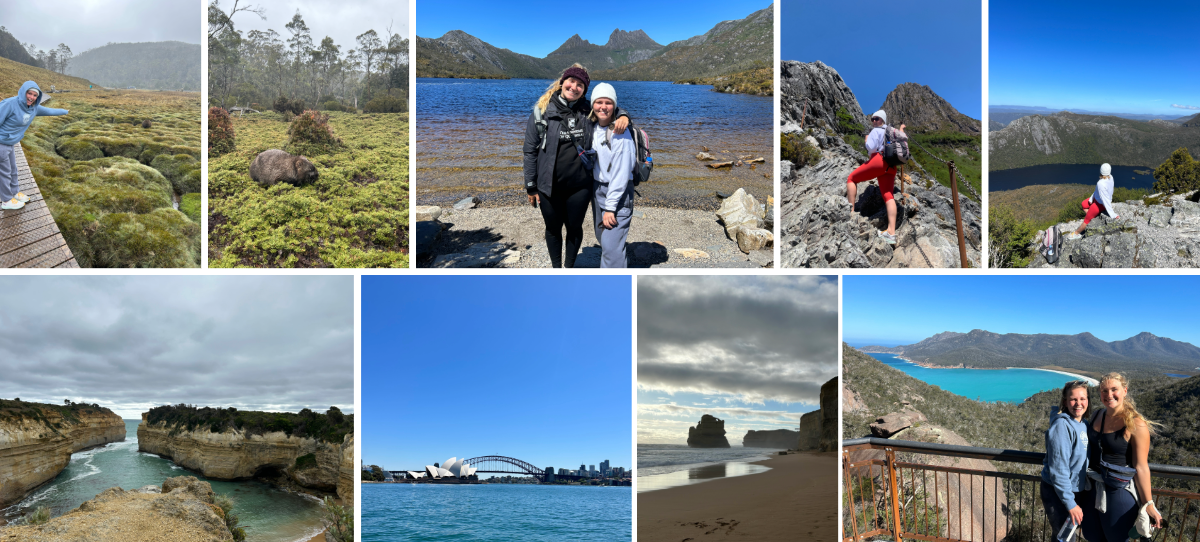 Photos from Lauren's trips to Sydney, Tasmania and Melbourne: Top 1: Lauren points at a wombat in Tasmania; a close-up of the wombat; Lauren with a friend before a big hike in Tasmania; Lauren hiking up the mountain in Tasmania; Lauren at the lookout point in Tasmania. Row 2: Loch Ard Gorge along the Great Ocean Road in Melbourne; the Sydney Opera House from far a distance; Gibson Steps on the Great Ocean Road in Melbourne; Lauren and a friend in front of Wineglass Bay in Tasmania
Photos from Lauren's trips to Sydney, Tasmania and Melbourne: Top 1: Lauren points at a wombat in Tasmania; a close-up of the wombat; Lauren with a friend before a big hike in Tasmania; Lauren hiking up the mountain in Tasmania; Lauren at the lookout point in Tasmania. Row 2: Loch Ard Gorge along the Great Ocean Road in Melbourne; the Sydney Opera House from far a distance; Gibson Steps on the Great Ocean Road in Melbourne; Lauren and a friend in front of Wineglass Bay in Tasmania Wetterau, one of 14 FNR undergraduates to complete their degrees in December 2023, is quick to point out several pivotal experiences in her time in the department ranging from her involvement in the Purdue student chapter of The Wildlife Society (TWS), mentorship from Dr. Elizabeth Flaherty and Summer Practicum.
Lauren was an officer for TWS for two years, acting as the FNR student council representative, which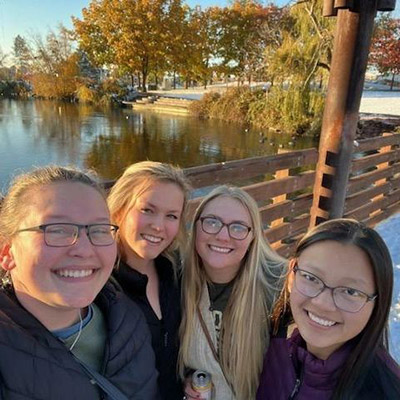 allowed her to “have so many valuable experiences and opportunities that I would not have had otherwise.” She attended two TWS national conferences, one virtual and one in-person, which strengthened her networking skills and gave her the opportunity to learn about important research in the wildlife field from current professionals and researchers.
allowed her to “have so many valuable experiences and opportunities that I would not have had otherwise.” She attended two TWS national conferences, one virtual and one in-person, which strengthened her networking skills and gave her the opportunity to learn about important research in the wildlife field from current professionals and researchers.
“Attending the in-person conference was particularly impactful for me, as I was able to physically see so many people around me who care about wildlife and the environment and the future of our planet as much as I do. It served as validation for me that this field is right where I belong,” Wetterau said. “TWS also helped me get to know my peers and professors, especially our faculty advisor, Dr. Flaherty. She has stood out to me throughout my time in FNR as a professor that goes above and beyond for her students to not only teach them in effective ways, but also help them succeed in professional settings to set them up for success after college. She’s the one who introduced me to the person who ended up being my advisor for my master’s program!
“Another standout for me was Summer Practicum. It truly was such a fun, impactful experience that gave me more hands-on practice with skills I’ll need in my future careers. It also gave me the chance to connect with my FNR peers and get to know everyone! Practicum gives you the ability to bond with everyone and share experiences together. I am very thankful for Practicum for bringing me great friendships!”
As she leaves the West Lafayette campus to head out into the world, Lauren leaves behind a bit of advice for those who may follow in her footsteps.
“My advice to future FNR students is say yes to opportunities because you never know what they might lead to,” Wetterau shared. “Join at least one club within your department/field and commit to being an active member in that club by attending meetings and going to events. That will help you meet other people with common interests and gain valuable experiences that could benefit your future career. Go to that career fair, sign up for that conference, run for that leadership position. And don’t be too intimidated by something to try it out; you have more skills and knowledge than you think you do!”
Wetterau took the next step in her natural resources career in January, when she began her master’s degree studies at the University of Wyoming. She will be studying red squirrels and how their middens impact biodiversity in the Greater Yellowstone Ecosystem under Dr. John Koprowski, who she met through Dr. Flaherty at The Wildlife Society’s annual conference in 2022.
“Community ecology is very interesting to me, so I found this research topic to be intriguing, especially in such a cool setting like Yellowstone,” Wetterau shared. “I am really looking forward to moving out West and working with people from the university and the national park. After I complete my master’s, I am hoping to start a career in endangered species conservation and management.”
